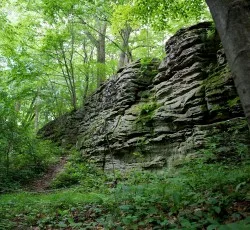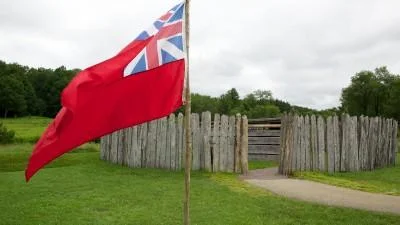The Battle of Fort Necessity is seen by many as the beginning of the Seven Years’ War, a global imperial conflict, in North America. The British hoped to expand trade into the interior ranges of America in search of greater profit. However, the French military had slowly expanded their presence in the same disputed territory and had ignored requests for immediate departure from the British government, one of which was personally delivered by a young George Washington in 1753 on the Allegheny Expedition. By the spring of 1754, competing claims over ownership of the Ohio Territory had reached their climax. Colonel George Washington marched his wounded and battle weary men out of the flimsy, wooden, circular defensive structure named Fort Necessity. Ultimately, French forces overwhelmed and defeated British forces at Fort Necessity on July 3, 1754.
Journey to Fort Necessity
On March 15, 1754, with the French refusal to evacuate the contested lands, Governor Robert Dinwiddie of Virginia gave Washington orders to depart with his force of 160 men to build a road along the Monongahela River and help defend the British fort at Wills Creek (today Cumberland, Maryland).1 Finding the area at Wills Creek to be already occupied by the French, Washington decided to push further west toward Redstone Creek, before finally settling on the establishment of a permanent position in a large clearing known as Great Meadows (today Farmington, Pennsylvania).
Washington selected the location for its apparent easy defensibility against assault from any side. While encamped at Great Meadows he received intelligence from the Seneca leader, Tanacharison, referred to as the “Half King.” He relayed to Washington that there was a small French force was encamped only six miles from their current location, and that they were aware of British presence in the area. Hoping to capitalize on the opportunity, Washington set off with a force of forty men under the cover of darkness in order to find the French forces.
Jumonville Glen Skirmish
When Washington located the French soldiers encamped for the evening, they fired upon him. Washington quickly devised and executed a plan for an attack on all sides, leaving by his accounts, ten French soldiers dead and taking twenty-one prisoners.2 Given the nature of Washington’s mission, an attack of this nature was controversial. Washington argued that the secretive nature of French forces indicated they were acting in a military capacity, and not a diplomatic one, Washington reporting that he and the other officers, “believe[sic] firmly that they were sent as spys rather than any thing else.”3 Among the dead was the leader of the French party, Ensign Joseph Coulon de Jumonville.

Fortification of Fort Necessity
Following this skirmish at Jumonville Glen, Washington immediately returned to Great Meadows and began fortifying Fort Necessity in anticipation of fierce French retaliation.4 Fort Necessity was smaller and simpler than the average mid-eighteenth century fort. Initially designed as staging area from which he could launch operations while awaiting a larger force of British regulars, the wooden structure stood alone in an open field incapable of withstanding a sustained offensive. Washington’s men dug hasty earthworks around the outside the walls of the fort from which they could easily fire on the enemy and take sufficient cover from the French volleys in hopes of holding out against the impending attack.
Battle of Fort Necessity and Aftermath
The French would strike back on the morning of July 3, with a force of 500 men and 100 Native American allies appearing in the tree-line around Fort Necessity. Washington quickly came to realize that the tree line provided ample cover and was well within musket range. The fight devolved into a standoff in a torrential downpour throughout the afternoon, with both sides sustaining significant casualties.5 With soaking gunpowder and a fighting force with low morale, Washington negotiated and accepted terms of capitulation in the late evening on July 3, surrendering his swivel guns, but maintaining the rest of his equipment.
In signing the terms of surrender, Washington unwittingly (likely due to a poor translation by Jacob Van Braam) acknowledged his role in assassinating Ensign Jumonville. That unfortunate political misstep, combined with open confrontation between French and British troops on the field of battle, instigated the expansion of the Seven Years’ War in North America. On July 4, Washington’s depleted force departed Fort Necessity in defeat. Even though his first significant mission as commander of troops was unsuccessful, George Washington had found his calling in life, “I heard Bullets whistle and believe me there was something charming in the sound.”6
Logan Davis, George Washington University
Notes:
1. “To George Washington from Robert Dinwiddie, 15 March 1754,” Founders Online, National Archives.
2. “From George Washington to Robert Dinwiddie, 29 May 1754,” Founders Online, National Archives.
3. “From George Washington to Robert Dinwiddie, 29 May 1754,” Founders Online, National Archives.
4. “From George Washington to Joshua Fry, 29 May 1754,” Founders Online, National Archives.
5. “IV., 1786: George’s Washington’s Account of the Capitulation of Fort Necessity,” Founders Online, National Archives.
6. “From George Washington to John Augustine Washington, 31 May 1754,” Founders Online, National Archives.
Bibliography:
Anderson, Fred. Crucible of War: The Seven Years’ War and the Fate of Empire in British North America, 1754-1766. Knopf Double Day Publishing Group, 2007.
Axelrod, Alan. Blooding at Great Meadows: Young George Washington and the Battle That Shaped the Man. Philadelphia, PA: Running Press, 2007.
Alberts, Robert C. A Charming Field for an Encounter: The Story of George Washington's Fort Necessity. Washington, D.C.: Office of Publications, National Park Service, U.S. Department of the Interior, 1975.
Calloway, Colin G. The Indian World of George Washington: The First President, the First Americans, and the Birth of a Nation. Oxford University Press, 2018.
Clary, David A. George Washington's First War: His Early Military Adventures. New York: Simon & Schuster, 2011.
Hindman, William Blake. The Great Meadows Campaign and the Climactic Battle of Fort Necessity. Leesburg, VA: Printed by Potomac Press, 1967.


